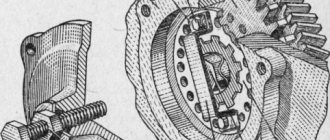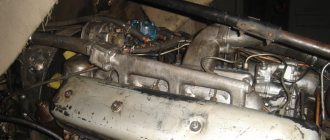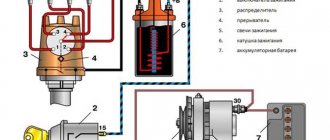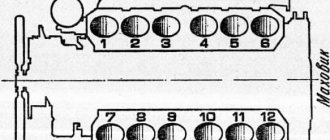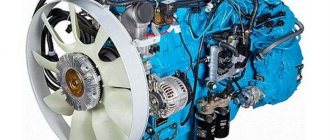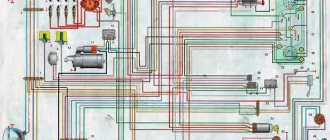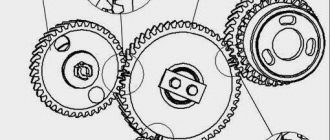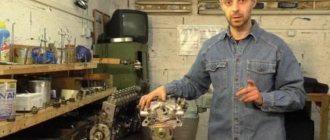Ignition of diesel fuel.
The piston compresses the air in the combustion chamber. The piston group allows you to create compression in the combustion chamber above 25 var. If this happens. The temperature of the compressed air rises to 700-900 degrees Celsius.
Heating the air in the combustion chamber
The air is heated. Because during compression the distances between air molecules decrease. Molecules are in constant motion. And the smaller the distance between them. the more often they collide with each other. As a result, a large amount of kinetic energy is released. Which turns into heat. The greater the pressure on the air, the smaller the distance between the molecules. The higher the temperature of the compressed air rises.
How does ignition occur?
The compressed air is heated to a temperature of 700-900 degrees. At the moment when the piston begins to approach top dead center. The injector injects fuel under pressure. The fuel is sprayed into small droplets. The movement of the drop begins to evaporate and a cloud of vapor forms around it. The ignition temperature of diesel fuel is 350 degrees Celsius. That is, at a compressed air temperature of even 500 degrees. Fuel vapors are guaranteed to spontaneously ignite. And they begin to expand from combustion. Pressure is created in the cylinder. By the time the piston approaches top dead center. The fuel will ignite completely and create maximum pressure in the combustion chamber. This pressure will do the engine work. As the piston moves away from top dead center, the fuel burns out. Thus creating additional pressure on the piston.
The quality of fuel combustion is largely determined by the pressure with which fuel is injected into the combustion chamber. The faster and more efficiently the fuel burns, the higher the pressure it creates. The higher the spray pressure in the nozzles. The smaller the droplets and the faster they move. Accordingly, they burn faster. Therefore, with the same volume of the combustion chamber, it is possible to achieve an increase in engine power by increasing the fuel injection pressure.
Adjustment procedure
Conversion of torque units.
units of torque, units of torque, units of torque, units of torque. table The need to install injection arises when replacing a high-pressure fuel pump (HPF) or installing it after repair, as well as after repairing the piston group of a diesel engine. The adjustment is carried out provided that the fuel equipment, injection pump and the adjusted gas distribution mechanism of the diesel engine are in good working order. The installation process consists of the sequential operations described below.
Installing the first cylinder on the compression stroke
On the right side, in the direction of travel of the machine, in the wall of the engine mounting to the clutch housing, above the longitudinal beam of the tractor frame near the oil filler neck, there is an installation dipstick. With its short threaded part it is screwed into the mounting wall and with its long threadless part it is installed outside. If it is necessary to install the first cylinder in the “compression” stroke position, the dipstick is installed in the hole, resting its long part against the engine flywheel. Slowly turning the diesel crankshaft, find the position at which the probe will fall into the hole on the flywheel and enter the body of the part completely by 4-5 cm
It is important not to confuse the installation hole with the technological, balancing drillings of the flywheel, which are much shallower in depth. The found position corresponds to an advance of 26 ̊ before the piston of the first or fourth cylinder approaches TDC
This position corresponds to the technical requirements of D 240 for setting the start of fuel injection into the cylinder during the “compression” stroke. To determine which of the cylinders in the first or fourth the “compression” stroke has begun, you need to remove the valve cover. A pair of closed valves will indicate in which of the two cylinders (first or fourth) the “compression” stroke has begun.
Installation probe for D 240
Disconnecting the pump drive
To establish synchronization of the engine and fuel injection pump operating cycles, you need to understand that the pump drive connecting through the engine timing gears must be disconnected. The drive is connected by connecting the holes of the pump drive gear 4 with the adjusting holes of a special washer 5 along the perimeter through a splined bushing fixed to the pump shaft. Access to the drive is achieved by opening the front cover 8 of the pump. To disconnect, unscrew two fastening bolts 3 with strip 7 and remove the adjusting washer from the splined sleeve. In this position, the rotation of the shaft cranks will not be transmitted through the camshaft gear drive to the pump shaft 6.
Injection pump drive device D 240
Momentoscope installation
After identifying the cylinder in the “compression” stroke and disconnecting the drive on the fuel pump, install a torque scope on the corresponding supply section of the pump instead of the high pressure pipeline connecting the section to the cylinder injector. To more accurately determine the beginning of the injection moment, set the manual fuel supply lever to the maximum position. To determine the moment of injection, if necessary, pump the fuel equipment with a manual pump pump, removing air from the system.
Injection installation operations
Determining and setting the timing of fuel supply
By turning the injection pump camshaft clockwise and observing the fuel level in the device tube, you need to determine the position of the pump shaft at the moment fuel supply begins in this section. The moment the supply begins will be the position at which the fuel level in the device tube begins to rise, shifting as a result of the start of the supply cycle, running the injection pump shaft cam onto the plunger pusher of the corresponding section
It is very important to determine, by observing the fuel level in the momentoscope, the beginning of this cycle
Injection pump drive with adjusting washer assembly Adjusting washer for the injection pump drive Splined sleeve in the injection pump drive Engine installation probe D 240
Setting the position of the pump drive shim
Having determined the moment of the start of injection on the section by the position of the injection pump shaft, connect the pump drive by installing a splined adjusting washer on the splined bushing. The fastening bolts with the strip are screwed into the most aligned holes of the washer and the flange of the pump drive gear. In this case, the bolts should fit freely without snagging. Then install the pump cover by tightening the three bolts around the perimeter of the cover. The axial clearance of the drive gear is adjusted using the adjusting central screw in the cover. To do this, unscrew the lock nut of the screw, screw it all the way into the washer bar and unscrew it 1/3 or 1/2 turn, after which the position is fixed with a lock nut.
Problems and malfunctions in the system
A sign of a system malfunction is engine overheating. The first reason may be a decrease in the coolant level as a result of leaking rubber connecting pipes. After identifying the cause of the leak, it is eliminated by tightening the sealing clamps or replacing the pipes if they break.
Attention! To check the fluid level, open the radiator cap carefully, as boiling water can splash out of the neck and cause burns. Before opening, allow the engine to cool slightly, then, standing on the windward side wearing protective gloves, open the lid.
Poor tension or broken pump and fan drive belt
The cause of diesel overheating may be insufficient performance of the water pump and fan as a result of slipping of the drive belt drive. Eliminate slipping by adjusting the belt tension. When installing or tensioning the fan belt in MTZ-80(82), the degree of tension changes by shifting the position of the generator, since the unit pulley simultaneously serves as a tensioner for the entire drive. To adjust, the generator mounting nut is loosened and the degree of tension is changed by shifting its housing. After setting the desired tension, the position is fixed by tightening the generator mount.
Removing air from the fuel injection system
Fuel injection system (injector)
Air bubbles in the fuel can impair the operation of the fuel injection pump or even make it impossible. In this regard, devices that are installed for the first time or are temporarily disconnected must be freed from air.
If the fuel priming pump is equipped with a hand pump, then it is used to fill the line, fuel filter and injection pump with fuel. In this case, the ventilation screws (1) on the filter cover and on the fuel injection pump must remain open until the escaping fuel contains no bubbles. Bleeding must be done every time the fuel filter is replaced or any work is done on the system.
During real-life operation, air is removed from the injection system automatically through the flow valve (2) on the fuel filter (continuous ventilation). A restrictor can be used instead of a valve if the pump does not have a flow valve.
Elimination of floating revolutions.
The barking of the engine occurs when the hazel grouse begins to walk in the splines of the injection pump shaft. Due to the slightest play of the hazel grouse and the fuel injection pump shaft, play is generated during engine operation. The pump, under the action of the plunger springs, begins to change the fuel injection angle and the engine barks.
All this can be eliminated in a simple way. We remove the ignition cover, unscrew the hazel grouse, and pull it out from the landing site. Using a welding machine, we weld small spots into the slots of the hazel grouse. Next, using a diamond file, we adjust it to the size of the pump shaft so that the hazel grouse fits tightly and there is no play.
This way we will remove the floating speed. If this does not help, then you will have to contact a fuel injection pump repair specialist, which means there is another problem, the pump cracks in the injection pump housing have worn out. The masters will replace them for you. Here are 2 reasons for the floating speed of the D-240 engine that I know.
How to properly install and adjust the ignition on MTZ-80 and MTZ-82 - Agrovesti.net
How does the mpi multipoint fuel injection system work?
The ignition on a tractor is very important, because thanks to it the mechanisms are put into action. The ignition is initially adjusted in the workshops.
In turn, the tractor has to work in difficult conditions, including difficult weather, which subjects the device to heavy load. As a result, breakdowns may occur, including magneto breakdowns. In such a situation, certain knowledge and skills will be useful.
If we consider the MTZ-80 and MTZ-82 tractors, then these common tractor models are equipped with the M124-61 mechanism. It is called a magneto and rotates to the right. This device has an ignition timing angle of twenty-seven degrees. When the mechanism rotates, a rigid half-coupling is engaged. It is supplied with an impulse by the PD-10 starter gear.
The magneto design consists of three components:
- transformer,
- breaker mechanism,
- rotor part.
The rotor is the generating element. It produces a variable current and directs it to a reliable and robust transformer. In turn, it increases the current value to even greater power - from 9 to 14.95 kW. Next, the current is addressed to the breaker. This action is a specific process, let's consider it. During rotary rotation, typical alternating voltage occurs. It is transmitted by magnetic flux to the transformer. The secondary winding of the magnetic flux produces a higher voltage. At the moment when the voltage value reaches its maximum, the breaker “removes” it from the first winding. As a result, the magnetic flux decreases, and electricity is generated in the electrodes of all spark plugs. Sparks occur and ignite the incoming fuel.
To perform repairs, you must perform the following steps. You need to remove the wires from the spark plugs and unscrew them. Next, a metal rod is inserted into the empty hole. The rod must be sterile, its radius must be less than the radius of the candle holes. We turn the main engine shaft in the direction of the clock hand. This action must be done until the piston is at top dead center. Then we turn the main engine shaft counterclockwise. This action must be done in such a way that the piston position is 5-6 millimeters below top dead center. Next, the breaker cover is removed from the magneto. The flywheel must be rotated and installed closer to the cam contact space. We push the protrusions of the magneto coupling half into the grooves of the drive gear. Be sure to tighten the bolts to secure the magneto itself. As a result, return the cover of the M124-61 mechanism to its original position, and the wires can now be reconnected to the engine spark plugs themselves.
In order for the magneto element to work properly, it is necessary to inspect it, as well as study the elements of the ignition system. After every 960 hours of engine operation, you need to look at the contacts of the magneto interruption mechanism, as well as the size of the gaps between them. During operation, soot, scale, and dirt deposits are most often created. As a result, it is necessary to clean the contacts, even if “Belarus” is idle. There is a special file for this operation. It does not leave abrasive chips or dust from metal particles.
After almost one and a half thousand hours of engine operation, it is necessary to check the condition of the cam lubrication. If there is not enough lubrication, you need to add a few drops of turbine oil. If the equipment is idle, it is necessary to lubricate the magneto rotor bearings every two years. To do this, it is necessary to remove the mechanism, disassemble it, and remove the remaining obsolete lubricant. Next, the device needs to be wiped and washed in gasoline.
agrovesti.net
Engine D 240 technical characteristics and maintenance
The Yaroslavl Motor Plant produces a number of engines, which are subsequently installed on various heavy equipment, and the D-240 engine with many modifications and a long history deserves special attention. The production of equipment began in the 70s, but also over many years of production, the Minsk Motor Plant was producing the same model. The D-240 modification from MMZ had fewer cylinders with reduced piston diameters and the cylinder itself. The initial version of the D-240 from the Yaroslavl plant had 4 cylinders and could produce power up to 80 horses.
The most popular tractor in the Soviet years was the MTZ 80, which was equipped with the D-240 engine. The tractor is still popular today, because the motor used has a long service life and the ability to operate in the most difficult temperatures. The power plant operated in 4-stroke mode on diesel fuel, as befits a completely simple and affordable modification; the equipment is liquid cooled and has a direct fuel injection system.
Technical characteristics of D-240
The engine volume specified by the manufacturer is 4.75 liters, 4 cylinders are installed, which provides it with a power of 80 hp. The cylinders are arranged in a row, the cylinder block is made of cast iron. Also, the cylinder has a diameter of 11 cm, the piston stroke is 12.5 cm. The equipment runs on diesel fuel and is quite unpretentious in maintenance, has a simple design that is understandable for the Russian user.
The design used is simplified as much as possible, which confirms the presence of conventional liquid cooling and a modernized cylinder block. The engine can be repaired even while working in the field, with a minimum of tools. Power figures in earlier engine modifications were 5 hp less. Engine performance and excellent traction at initial speeds are ensured by direct fuel injection. The D-240 starts with an electric starter, so starting the tractor in winter will be much easier and more confident.
Engine cooling system D-240
The D-240 is equipped with closed-type liquid cooling, so the motor is used on the MTZ-80 and MTZ-82 tractors. The closed type of cooling is quite a bold solution, because contact with the environment occurs for a split second and only through the valve. In order not to overheat the engine, the fluid must be at the optimal temperature, which ranges from 80-97 degrees. This indicator is monitored by a thermometer; it is possible to manually adjust the temperature using a special curtain.
Advantages of the D-240 engine
Of course, the production of thousands of engine units indicates great demand for this modification; the manufacturer has provided a number of systems and good power for use on MTZ tractors. The main advantages of the power plant include:
The durable cast iron used for the cylinder block allowed the equipment to be protected from overheating, so the block did not crack when operating for too long. Without fail, the manufacturer decided to use a special form of valve mechanism, thanks to which the valves were maximally protected from damage when the timing chain breaks.
Maintenance of the D-240 engine
As mentioned above, the engine had an excellent service life and did not require replacement of parts, much less major repairs, for years. To avoid breakdowns, it is important to perform proper maintenance and use high-quality fuel and oil. Service occurs in the following stages:
Some craftsmen carry out tuning of a domestic engine, for example, to increase power to 100 horses, you can install a turbine and a special fuel supply system. Some owners complain about increased fuel consumption. Today, almost all working tractors MTZ 80 and 82 work with the D-240 engine.
Video
Operating principle of the injection advance device
The injection advance device is driven by a toothed gear, which is installed in the engine timing gear drive housing. The connection between the input and output for the drive (hub) is made through locking pairs of eccentric elements.
The largest of them, the adjusting eccentric elements (4), are located in holes in the locking disk (8), which, in turn, is bolted to the drive element (1). Compensating eccentric elements (5) are installed in the adjusting eccentric elements (4) and are guided by them and a bolt into the hubs (6). On the other hand, the hub bolt is directly connected to the hub (2). The weights (7) are connected to the adjusting eccentric element and are held in their original positions by springs with variable stiffness.
Design of the cooling system of the MTZ 80(82) engine and its modifications
The closed system is isolated by a lid with a steam-air valve from the external atmospheric environment. For circulation, the system is equipped with a centrifugal pump, which creates a fluid flow increasing heat transfer performance.
Water jacket
The cavities in the block and the gas distribution head between the inner and outer walls of the part are called the engine water jacket and are connected by a heat-resistant metal-asbestos gasket. The circulation of liquid in the cavities ensures heat exchange and maintains the thermal balance of the working cylinders of the piston group and the gas distribution mechanism.
How to set the ignition on a diesel engine
How to set the ignition on a diesel engine? The need to solve this problem may arise in one of the following cases:
After the timing belt was replaced.
After the high pressure fuel pump has been removed or replaced. After this, it may be impossible to find the marks where the pump pulley was installed. Therefore, before starting repairs, it is better to update the tags, so as not to suffer with the ignition later. You can do this in different ways, such as applying paint around the mark.
But if you still have a problem with setting the ignition, you can go in two ways.
How to set the ignition on a diesel engine. Method No. 1
The first way is to set the ignition using the trial and error method. It should be noted right away that this method is not optimal. Moreover, if the ignition is set for too long in this way, it does not add survivability to the engine and reduces its service life. But this method is still worth considering.
How it's done
• Once the pulley is installed, an attempt is made to start the engine. If the diesel engine does not start at all, the pump pulley rotates in relation to the belt by 3-5 teeth. An attempt is made again to start the engine.
• If the engine starts after several movements, you need to understand how a diesel engine works. If you hear a knock, you need to turn the pump pulley 1-2 teeth in the direction opposite to the rotation of the pulley.
• If there is a lot of smoke coming out of the exhaust pipe when the engine is running, this means that there is a delayed injection of diesel fuel. In this situation, the pump pulley must be turned one tooth forward in relation to the belt.
• If all these actions do not help, you will have to loosen the pump and by turning it around the axis, try to achieve normal operation of the diesel engine. Ideally, a diesel engine should operate on the edge of detonation levels. As soon as detonation begins, it becomes audible through the sound of the engine.
How to set the ignition on a diesel engine. Method No. 2
The second way of setting the ignition is more correct from a technical point of view.
How it's done
• The high pressure pipe from the injector of the 1st cylinder is removed.
• A transparent plastic tube is placed over the high-pressure tube (tubes are sold at any hardware store). The transparent tube should be vertical.
• The ignition is turned on and the pump pulley is rotated with the key. As you rotate, we determine the upper point of the fuel position in the tube, and accordingly in the nozzle. The pulley must be rotated very slowly and smoothly, without sudden jerks.
• Once the desired point is found, a mark is placed on the pulley.
• After this, the positions of the camshaft and crankshaft are set using the marks.
You can set the timing of diesel fuel injection even more accurately by moving the fuel pump. But if the pump was not removed before repair, then there is no point in touching it.
If all these steps seem too complicated, then it makes sense to contact an experienced mechanic or an appropriate service whose specialists know perfectly well how to set the ignition on a diesel engine.
But in order to eliminate the possibility of setting the ignition again, it is necessary to update the marks before any repairs related to removing the belt or injection pump.
Design of the injection advance device
The injection advance device for an in-line injection pump is installed directly at the end of the injection pump cam shaft. The main differences between injection advance devices are open type and closed type.
The closed-type injection advance device has its own lubricating oil reservoir, which makes the device independent of the engine lubrication system. The open design is connected directly to the engine lubrication system. The body of the device is screwed to the gear, and the compensating and adjusting eccentrics are installed in the body so that they rotate freely. The compensating and adjusting eccentrics are guided by a pin, which is rigidly connected to the body. In addition to lower price, the “open” type has the advantage of requiring less space and lubricating more efficiently.
Operating principle of the ignition system
The ignition system is used for reliable and timely ignition of the combustible mixture entering the cylinder. It consists of a magneto, a spark plug and a high voltage wire.
The operating principle of this element is quite simple and reliable at the same time - when the working mixture enters the cylinder of the starting engine, it is ignited by means of an electric charge formed between two electrodes on the spark plug. For the highest quality charge, a fairly high voltage is required, approximately 10-15 kV, which is created in a special device - a magneto, which combines a number of functions - a breaker, an alternating current generator and a transformer.
Engine Description
The unit is a four-cylinder diesel engine, the cylinder block of the unit is reinforced, made of cast iron, the engine capacity of the D240 is 4.75 liters. The power plant is naturally aspirated, characterized by increased reliability and simplicity of design. The motor is easy to repair; the procedure is possible even in the field.
Since the power plant is diesel, the fuel supply is injection, the engine is provided with the necessary thrust and sufficient power. In addition, the D240 engine has a torque of 28 kgf*m, which is enough to complete most of the tasks. The process of starting the D240 power plant occurs using an electric starter; the D240L modification is equipped with a starting motor, which helps facilitate the start of the main unit in the cold season.
Classic fuel injection system.
Based on the use of a high pressure fuel pump. It distributes fuel pressure across the cylinders. Depending on the operating pattern of a given engine. The injection pump cavity is filled with fuel using a booster pump. Which is located on the fuel injection pump housing and is driven by the injection pump shaft. The booster pump pumps fuel from the tank and directs it to fine filters. And then the fuel enters the injection pump. The high pressure fuel pump cavity fills. It contains plunger pairs. They grab fuel. And they create high pressure. Which is supplied to the injectors. The nozzle is designed like this. Which accumulates the resulting pressure from the plunger. And when the required pressure is reached, it opens channels through which fuel is sprayed. This is a classic scheme. The pump allows you to change the engine crankshaft speed. By changing the amount of fuel supplied to the cylinders.
In addition, some pumps have the ability to change the ignition timing. Through the use of centrifugal weights. As the engine speed increases, the pump shaft shifts relative to the drive. This system is designed for average engine performance. At various expected operating modes. And cannot influence unintended loads. Such as a decrease or increase in transported cargo. Descent ascent. Road surface. The amount of fuel will correspond only to the required engine speed.
Accordingly, there will either be not enough fuel. Or an excessive amount is served. As a result, complete combustion of fuel in the cylinders is not achieved, and as a result, low efficiency. Negatively affecting fuel consumption, engine power and environmental performance. Environmental requirements ultimately turned out to be the main factor in the evolution of the injection system. The better the fuel burns in the combustion chamber. This creates less harmful emissions into the environment. Accordingly, the more efficient the combustion of fuel, the better the engine performance. The designers have been improving the diesel fuel injection system for a long time.
But all of these were usually variations on the fuel injection pump theme. Fuel injection was carried out in full. Therefore, when the diesel engine is running, a characteristic knock is heard. The fuel supplied to the cylinder ignites, the pressure increases at TDC to its maximum value. And a strong blow occurs.
A modern diesel engine injection system is capable of delivering injection in several stages. How to pre-ignite fuel. Preliminary injection of fuel is called pilot injection. When the piston passes the ignition timing mark, fuel is pre-injected. A small amount of fuel ignites. Then some more fuel is given.
There can be up to 5 such preliminary injections. After the pilot injection, the main injection occurs. Already into burning fuel. The bulk of the fuel ignites faster and burns more efficiently. As a result, the engine runs smoothly without harsh shocks. And more complete combustion of fuel ensures low emissions of harmful substances and increased engine power characteristics. Such an injection can only be provided by the Comon Rail system.
Which direction does the D 240 engine spin?
The function of the cooling system of an internal combustion engine is to ensure a thermal operating balance in which all parts of the mechanisms are free from jamming, taking into account thermal expansion and ensuring optimal sliding in all rubbing surfaces. The factor of the temperature regime of the unit’s operation affects the wear of engine parts, output power and fuel consumption and, as a consequence, all operational indicators.
water cooling engine
For the D 240 diesel engine, the optimal operating mode is a temperature of 80 - 95 ̊ C.
An additional function of the system is heating the cabin of the MTZ 80 (82) tractor during the cold season through an additional heat exchanger - a stove equipped with a blower fan with an electric motor.
Injection pump lubrication
It is best to connect the injection pump and regulator to the engine lubrication system, because With this form of lubrication, the injection pump remains maintenance-free. Filtered engine oil is supplied to the injection pump and regulator through the discharge line and the inlet channel through the roller tappet hole or using a special oil supply valve. In the case of a base or frame fuel injection pump, the lubricating oil is returned to the engine via the return line (b).
In the case of flange mounting, the return of lubricating oil can occur through the camshaft bearing(s) or through special channels. Before turning on the injection pump and regulator for the first time, they must be filled with the same oil as the engine. In the case of an injection pump without a direct connection to the engine oil system, oil is poured in through the cover after removing the air bleeder cap or filter. The oil level in the pump is checked by removing the oil level screw on the regulator at the intervals prescribed by the engine manufacturer for changing the engine oil. Excess oil (an increase in the amount due to oil leakage from the lubrication system) must be drained, and if there is not enough oil, then add fresh oil. When the injection pump is removed or when the engine undergoes major repairs, the lubricating oil must be replaced. To check the oil level, injection pumps and regulators with a separate oil supply are equipped with their own dipstick.
Lubrication system D-240
The D-240 diesel engines use a combined single-circuit lubrication system. Pump 2 (Fig. 1) sucks oil through oil intake 1 and pumps it into full-flow active-reactive (nozzleless) centrifuge 4. Then the oil through radiator 5 or bypassing it enters the crankcase line to the crankshaft main bearings and camshaft bearings.
It is fed from the main bearings through drillings in the cheeks to the connecting rods. From the camshaft journal, oil flows in a pulsating flow into the internal cavity of the rocker arm axis, and through the holes in it to the rocker arm bushings.
Through the channels in the rocker arms, oil flows to the spherical surfaces of the pusher rods.
Fig. 1.7 Interaction of devices of the D-240 lubrication system: 1 - oil intake; 2 - pump; 3 - safety valve; 4 — centifuga; 5 - radiator; 6 — pressure gauge indicator; 7 drain valve; 8 — radiator thermostat valve; Кн Ш - main and connecting rod bearings; P - camshaft support; PN and PSh - fuel pump drive gears and intermediate: VK - rocker arm bushings
Cylinder liners, pistons, tappets, camshaft cams, gear teeth and other parts of the D-240 are lubricated with oil flowing from the bearing clearances.
Safety valve 3 limits the oil pressure at the filter inlet to no more than 0.7 MPa.
Reducing valve (thermostat) 8 bypasses cold oil into the line past the radiator. This speeds up the warming up of the oil and the D-240 engine. Drain valve 7 limits the operating pressure in the main line within 0.2...0.3 MPa.
To monitor the oil pressure in the lubrication system of the D-240 engine, use pressure gauge 6
The D-240 fuel pump with a regulator and the starting motor with a gearbox have autonomous lubrication systems.
The rotor of the active-reactive centrifuge D-240 is freely mounted on axis 1 (Fig. 2.).
A nozzle 7 is fixedly attached to it, having channels H located tangentially to its circumference.
Channels B in the upper part of the rotor column are designed in a similar way. The oil pumped by the pump enters the nozzle 7 through channel 5, the annular channel and holes in the axis, and from there it exits through channels H into the cavity NP of the rotor column.
Jets of oil, which come out at high speed and are directed by channels H along the tangential and inner wall of the column, create an active torque that causes the rotor to rotate. From the cavity of the NP column, through its radial holes, the oil enters the cavity of the rotor 3, where it is cleaned of foreign impurities (as described above).
The oil to be purified passes through channels B in the upper part of the column into the VP cavity. In this case, reactive forces arise, the torque of which coincides with the active torque.
These torques, when added together, ensure rotation of the rotor at a frequency of about 6000 min'. The cleaned oil from the cavity of the VP is directed through a channel and a tube in the axis to lubricate the rubbing surfaces.
Cool the oil to prevent the viscosity from decreasing below the limit and slowing down the oxidation process. The radiators currently used on MTZ tractors can reduce the oil temperature by 10-15°C
We adjust the injection experimentally
Injection adjustment is made experimentally after installing the pulley. After installing the pulley, start the engine. If it does not start, then rotate the injection pump pulley relative to the timing belt by 2-4 teeth.
Start the engine again.
After the manipulations we have performed, it should start, listen to the operation of the motor. Obvious knocking sounds mean detonation; you need to turn the pump pulley in the direction 1-2 teeth opposite to its rotation. Thick gray smoke means late injection, then the pump pulley must be turned 1 tooth in the direction of its rotation.
If there are no changes for the better in the operation of the diesel engine, you need to rotate the pump around the axis. With such rotations it is necessary to achieve optimal operation of the unit. The best setting option would be to work in the mode before detonation knocks appear. They are very audible when the diesel engine is running.
The second method of the experimental method involves the following steps:
We unscrew the tube that goes from the pump to the injector on the first cylinder. Pull a transparent hose onto the removed end of the tube and place it in a vertical position.
Now you need to turn on the ignition and slightly turn the injection pump pulley. Rotate the pulley little by little, slowly and very carefully. At the same time, monitor the fuel level in the transparent hose. Determine the highest limit. When the diesel level is at the upper limit, make a mark on the pump pulley.
After this, the camshaft and crankshafts are set according to the marks. Start the engine and check its operation. If there are signs of improper injection, repeat the adjustment procedure again. If it still doesn’t work out, contact the service station, they will fix everything and, if necessary, adjust it at the stand.
That's all, friends, until we meet again, subscribe to the site update, if you haven't yet, share the link with your friends, if you haven't done so yet, there will be a lot more useful stuff.
Source
Adjusting the fuel injection pump on the engine
The fuel injection pump is synchronized with the engine using timing marks to start injection (closing the channel). These marks are located on the engine and on the fuel injection pump.
Typically, the engine's compression stroke is used as the basis (the reference point for injection timing adjustments, although other possibilities may be used for a particular engine model)
In this regard, it is important that the manufacturer's instructions are taken into account. In most cases, the timing mark for closing the channel is located on the engine flywheel, on the V-belt pulley or on the vibration damper
There are several possibilities for adjusting the injection pump and setting the correct value for the start of injection (closing the channel).
- The fuel injection pump is delivered from the factory in a form where its cam shaft is locked in a predetermined position. After installing the injection pump on the engine and strengthening it with bolts, when the crankshaft is in the appropriate position, the cam shaft of the injection pump is released. This well-tested method is inexpensive and is becoming more and more popular.
- The injection pump is equipped with a channel closing indicator at the end of the regulator, which must be aligned with the installation marks when the injection pump is installed on the engine.
- The injection timing advance device (clutch) has a mark for closing the hole, which must be aligned with the mark on the injection pump body. This method is not as accurate as the two described earlier.
- After the fuel injection pump is installed on the engine, a high pressure flow method is used at one of the pump outlets to determine the point (moment) of channel closure (i.e., when the plunger closes the fuel outlet channel). This "wet" method is also being actively replaced by method 1 and 2 described earlier.
Adjusting the boost corrector
The start of the rod movement should occur at an air pressure in the space above the diaphragm equal to 0.005-0.010 MPa.
In the absence of pressure in the supra-diaphragm space, the average cyclic flow is set by moving stop 46 (see Fig. 1) and should be 60...70 mm3/cycle at a pump camshaft rotation speed of 550 min-1. Adjustment of the start of movement of the diaphragm 51 (rod 54) must be done by changing the pre-compression of the spring by screwing in or unscrewing the sleeve 50.
What is the injection pump used for?
The main difference between a gasoline unit is the ignition of the combustible mixture inside the cylinders. In a gasoline engine, the mixture is ignited by spark plugs. In a diesel engine, the mixture spontaneously ignites under compression. The injection pump is needed for the timely supply of diesel fuel to the cylinders at the moment of compression.
By design, injection pump pumps differ as follows: in-line type, main type and distribution type. In an in-line engine, diesel fuel is pumped into each cylinder from its own pair of plungers. The distributor provides all cylinders with one or two pairs of plungers. Mainline devices are used to pump diesel fuel into the fuel accumulator.
Remember, injection pump and injectors are the main elements of the diesel ignition system. They are present in most diesel units and are of the electronic type.
When it is necessary to adjust injection
At the factory there is a special machine for adjusting the injection pump. Therefore, it works well without adjustments. But, there are times when, after some repair work, you have to adjust the injection angle, for example:
- After replacing the timing belt
- You removed the fuel injection pump, and you cannot install its pulley according to the special marks.
- Any other unavoidable repair work that disrupts the injection angle adjustment.
Let me remind you, dear readers, that to fully adjust the fuel injection pump you need a special stand. Therefore, disassembling it into parts or turning all the screws on it is simply stupid. You will misadjust the device so much that later, without a stand, you will no longer be able to adjust the operation of the motor back. Therefore, if you don’t understand what and why to turn, do not touch the pump’s full load screw and other screws, because you will not be able to adjust them back. You don't need extra problems and expenses, do you?
Useful tips
You can regulate the ignition on a diesel engine in the following ways:
- Adjustment by marks, if any.
- Selection of injection experimentally.
Why is ignition timing necessary?
Let's look a little at the theory of internal combustion engines.
So, in automobile engines, the piston in the engine cylinder moves back and forth, that is, up and down.
In this case, the entire movement is divided into 4 parts (cycles), the so-called strokes (there are also 2-stroke engines, but we will not consider them).
One of these strokes is the power stroke, during which the piston moves down.
It is the most important, since this stroke carries out the transformation (ignition is accompanied by the release of a large amount of energy, which puts pressure on the piston, causing it to move, which in turn ensures rotation of the crankshaft).
All other strokes are preparatory, that is, the remaining three strokes do everything to ensure that the working stroke occurs, namely, they fill the cylinders with mixture components, ensure their compression and remove combustion products.
Read the operating principle of a two-stroke and four-stroke engine here https://autotopik.ru/obuchenie/851-princip-raboty-dvigatelya.html.
Theoretically, in order to obtain maximum efficiency, ignition of the mixture - the ignition moment - should occur when the piston reaches TDC (it will begin to move down), then the released energy will have a maximum impact on it.
In reality, everything is somewhat different. Fuel combustion does not occur instantly, and this process takes time.
And if you ignite the mixture with the piston position at TDC, then before the moment when the maximum amount of energy is released, it will already go down, and the beneficial effect of the entire process will be reduced, and significantly, since the energy will work “to catch up”.
To obtain maximum efficiency, the air-fuel mixture ignites a little earlier than the piston reaches TDC.
As a result, by the time the piston reaches the top point and crosses it, the mixture will have time to burn completely and the impact of the energy released in this process on the piston will be maximum.
This feature of the processes in the engine even received its own designation - ignition timing. It is also called the ignition timing because the measurements are made based on the rotation of the crankshaft.
That is, the ignition timing is the angle by which the crankshaft does not turn until the piston is at TDC.
Set the angle according to the marks
For the first method of independently adjusting the injection of a diesel unit according to marks, the possibility of shifting the fuel injection pump is implied. The method is only suitable for a mechanical apparatus. The injection timing is adjusted by turning the injection pump around its axis. This method is also suitable if it is possible to rotate the camshaft timing pulley relative to the hub.
The method is suitable when the pulley and pump are not rigidly fixed.
To adjust the ignition in this way, you need to get to the back of the engine housing, where the casing with the flywheel is. If necessary, you will have to remove this cover.
Then you need to find a stopper on the flywheel that fits into the slot. After this, rotate the flywheel manually (using a wrench or other device). The rotation of the flywheel causes the engine crankshaft to twist. Turn clockwise until the locking mechanism located on top engages.
After this, look at the drive shaft on the injection pump. If the scale on the coupling through which rotation occurs is in the upper position, then the mark on the pump flange is aligned with the zero mark of its drive.
When the marks are aligned, you can tighten the fastening bolts.
If the scale does not line up with the drive marks, then lift the flywheel stopper and turn it one turn until the stopper engages again. After the stopper is activated, check the position of the scale again. If the marks coincide, secure with fastening bolts.
After you have tightened all the drive coupling bolts, lift the stopper and turn the crankshaft 90 degrees, then place the stopper in the groove.
The last step in the work is to return the flywheel housing if it had to be removed.
The operation check is as follows: start the engine and check. At idle, it should hum softly and evenly, without jerking or dips. If the work is tough and detonation knocks are heard, this is not acceptable. This means the adjustment is incorrect, unscrew the bolts and start again.
Now slowly and without unnecessary load, check the operation of the unit in motion. Warm it up to operating temperature and step on the gas
Pay attention to the color of the exhaust. Gray black smoke indicates late fuel injection
The absence of side effects indicates that all parameters are normal.
Advice from practitioners
- If it is necessary to dismantle the injection pump to maintain the positions of the engine and pump operating cycles with a set injection angle, dismantle the unit in the position of the diesel crankshaft when the flywheel hole and the installation probe coincide with the compression stroke in the first cylinder. Fix the position of the injection pump shaft. During assembly, you will simply need to install the crankshaft in the appropriate position and install the pump.
- On engines with high output, the meshing of timing and drive gears creates an effect of additional injection advance. To eliminate this, install the injection later, individually selecting the offset of the adjusting washer counterclockwise.
- If the engine operates unstable at idle, pay attention to the play formed as a result of wear on the splines of the drive sleeve and the pump adjusting washer. Wear may be a consequence of changes in fuel injection angles, which cause unstable diesel operation.
- If it is necessary to adjust the injection, to monitor the operating order of the cylinders and determine the compression strokes, you can loosen the fittings of the fuel injection pump sections and, by turning the crankshaft, observe the frequency of fuel leaks. The appearance of fuel leakage on the pump section will indicate the moment of the compression stroke in the corresponding diesel cylinder. This technique eliminates the need to remove the valve cover to inspect the valves.
How to set the ignition timing with your own hands
Setting the ignition correctly means that you need to find the desired ignition timing (IAF). The tuning is done at idle, although this is understandable, but suddenly someone decided to put the car on a jack and tune it at speed.
To adjust the ignition, you need to know that the optimal good engine crankshaft speed at idle is from 850 to 900 rpm. The ignition timing angle should be between -1 and +1 degrees. This is a degree relative to top dead center (TDC).
If a light bulb is used for adjustment, it is connected to the positive terminal on the ignition distributor (distributor), and the light bulb base is connected to ground. Let's look at the configuration options separately.
Strobe setting
- Start the engine, heat it to operating temperature and turn it off.
- Connect the strobe light to the car's network.
- Unscrew the nut securing the distributor cap - ignition breaker.
- Place the alarm sensor on the high-voltage wire of the first cylinder.
- If there is a vacuum corrector hose on the distributor, then it must be disconnected and plugged.
- Direct the strobe light onto the engine crankshaft pulley.
- Now start the engine and leave it idling.
- Now you need to turn the distributor body and fix it so that the mark on the crankshaft pulley coincides with the mark on the timing mechanism.
- If the marks match, tighten the nut.
How to set the ignition with a control light
- Rotate the engine crankshaft until the mark on its pulley coincides with the timing mark.
- In this case, the ignition distributor slider should be directed to the first cylinder.
- Now you need to loosen the distributor nut.
- One wire is connected to the core of the warning lamp (control) and to the ignition coil wire (bobbin).
- The second wire connects the ground and the light bulb base. The light should light up.
- After this, you need to turn on the ignition by turning the ignition key and turning the distributor body clockwise. When the distributor rotates, the light will go out in some position. In this position, tighten the distributor clamping nut.
Adjustment of valve clearances P-23U
Adjust the valve clearances on a warm engine. Remove the valve mechanism hatch covers ( ) and the clutch housing, unscrew the spark plug of the first cylinder to determine the compression stroke, turn the crankshaft with the crank until the “TDC 1C” mark on the end of the flywheel coincides at the end of the compression stroke of the first cylinder with a mark on the flange of the housing hatch clutches. In this case, both pushers of the first cylinder will be in their lowest position.
Additionally, turn the crankshaft by 70...90° using the starting handle, which corresponds to a circumference around the flywheel rim of 143...184 mm. In this position, all four valves will be completely closed.
Rice. 133. Adjusting the starting motor clutch
Check the gaps 2 (Fig. 134) with a feeler gauge 1 between the ends of the valve stems and the adjusting bolts of the valve pushers. With a warm engine, the clearance of both valves should be 0.2...0.25 mm. If the gap is more or less than 0.2...0.25 mm, then loosen the lock nut on the pusher adjusting bolt and, rotating it, set the gap to 0.2...0.25 mm, then tighten the lock nut and check the gap again. Rotate the crankshaft two turns and check the clearances again.
